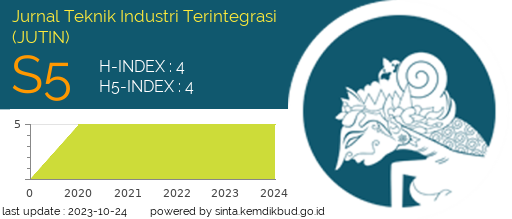Implementasi Metode Fuzzy Time Series dalam Peramalan Penjualan Produk Unggulan Perusahaan
DOI:
https://doi.org/10.31004/jutin.v7i1.21249Keywords:
Forecasting, Sales, Fuzzy Times SeriesAbstract
This research discusses sales forecasting of two superior products of PT. Pakis Logam Perkasa Indonesia: semi-stainless spatula and electric elbow grater c. One of the household furniture manufacturers in Tulungagung sells its wholesale and retail products. Due to the high demand for semi-stainless spatula and c-elbow electric grater products, the company experienced uncontrolled inbound and outbound sales. Therefore, sales forecasting is imperative. Sales forecasting uses previous data to decide how many products to market. Chen's Fuzzy Time Series model uses a technique for forecasting the demand for semi-stainless spatulas and c-elbow electric grates for the next month based on previous data patterns. The two methods used to analyze data are qualitative analysis and quantitative analysis. The aim of creating this forecasting model is to improve forecasting results, especially in terms of accuracy. Next, the Mean Absolute Percentage Error (MAPE) determines the error value from the forecasting results. The error value for the semi-stainless spatula product is 1.03%, and the c-elbow electric grater is 0.62%. The MAPE test shows that the forecasting results of these two products are excellent.References
Al-adawiyah, S. H. (2021). Perbandingan tingkat akurasi metode average based Fuzzy Time Series Markov Chain dan Algoritma Novel Fuzzy Time Series: Studi kasus harga beras di tingkat perdagangan besar Indonesia. Universitas Islam Negeri Maulana Malik Ibrahim.
Aminudin, R. (2019). Model Peramalan Garis Kemiskinan Menggunakan Metode Double Exponential Smoothing dari Holt. Universitas Komputer Indonesia.
Chen, S. M. (2002). Forecasting enrollments based on high-order fuzzy time series. In Cybernetics and Systems (Vol. 33, Issue 1). Fuzzy Sets and Systems. https://doi.org/10.1080/019697202753306479
Darmawansyah, D., & Gemasih, H. (2023). Peramalan Harga Tomat Menggunakan Metode High Order Fuzzy Times Series Multifactors. Jurnal Sistem Informasi Dan Ilmu Komputer, 1(3), 141–162.
Fachrurrazi, S., Pratama, A., Syukriah, S., & Ilhadi, V. (2023). Penerapan Fuzzy Times Series dan Regresi Linier dalam Melihat Stok Ketersediaan Beras. METIK JURNAL, 7(1), 26–35.
Fathoni, M. Y., & Wijayanto, S. (2021). Forecasting Penjualan Gas LPG di Toko Sembako Menggunakan Metode Fuzzy Time Series. JUPITER (Jurnal Penelitian Ilmu Dan Teknik Komputer), 13(2), 87–96.
Fyanda, D. A., Ula, M., & Asrianda, A. (2017). Implementasi Fuzzy Time Series Pada Peramalan Penjualan Tabung Gas Lpg Di Ud. Samudera Lpg Lhokseumawe. Sisfo: Jurnal Ilmiah Sistem Informasi, 1(1).
Gusman, A. P., & Kurniawan, H. (2018). Fuzzy Logic Dalam Menganalisa Pengaruh Konsep Halal Tourism Terhadap Perilaku Masyarakat Sumatera Barat. Jurnal Matematika UNAND, 7(2), 235–242.
Inayati, S., Yuliana, Y., & Hanafiah, A. (2021). Prediksi Jumlah Peserta BPJS Penerima Bantuan Iuran (PBI) APBN menggunakan Metode Fuzzy Time Series Cheng. Barekeng: Jurnal Ilmu Matematika Dan Terapan, 15(2), 373–384.
Khaira, U., Utomo, P. E. P., Suratno, T., & Gulo, P. C. S. (2019). Prediksi Indeks Harga Saham Gabungan (IHSG) Menggunakan Algoritma Autoregressive Integrated Moving Average (ARIMA). JUSS (Jurnal Sains Dan Sistem Informasi), 2(2), 11–17.
Rahmad, C., Wibowo, R. S., & Puspitasari, D. (2019). Peramalan Penjualan Daging Sapi Menggunakan Metode Trend Least Square. Jurnal Teknologi Informasi Dan Terapan, 6(1), 7–11.
SAHULATA, E. R. Y., Wattimanela, H. J., & Noya Van Delsen, M. S. (2020). Penerapan Fuzzy Inference System Tipe Mamdani Untuk Menentukan Jumlah Produksi Roti Berdasarkan Data Jumlah Permintaan Dan Persediaan (Studi Kasus Pabrik Cinderela Bread House Di Kota Ambon). BAREKENG: Jurnal Ilmu Matematika Dan Terapan, 14(1), 079–090. https://doi.org/10.30598/barekengvol14iss1pp079-090
Sunarya. (2016). Pengembangan Sistem Klasifikasi Stadium Malaria Plasmodium Falciparum pada Citra Mikroskopis Sel Darah. Universitas Pendidikan Ganesha Bali, 5(1), 36–42.
SYAFRIDA, I. (2021). PERAMALAN INDEKS SAHAM SYARIAH INDONESIA (ISSI) DENGAN MENGGUNAKAN METODE FUZZY TIME SERIESMARKOV CHAIN. Muhammadiyah University, Semarang.
Wirajaya, I. G. A. (2015). Kemampuan Laba, Arus Kas Operasi Dalam Memprediksi Arus Kas Masa Depan. E Jurnal Akuntansi Universitas Udayana, 10(3).
Downloads
Published
How to Cite
Issue
Section
License
Copyright (c) 2024 Florencia Agatha Damayanti, Lilis Nurhayati

This work is licensed under a Creative Commons Attribution-ShareAlike 4.0 International License.





